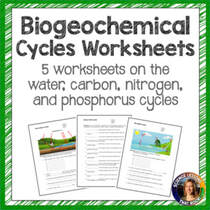
Ahhh the biogeochemical cycles. They are vital to life, but students don’t typically enjoy learning about them. They usually know the water cycle by the time they reach high school, but struggle with carbon, nitrogen, and phosphorus. I’ve rounded up some resources you can use to spice up your chemical cycles unit. Don’t forget to repin this blog post for later by clicking here!
1. Calculate Your Water Usage- Since most students already know the water cycle, don’t spend a ton of time on it. Instead I focus on their water usage. Many students will think you are crazy when you tell them it’s not sustainable to take 20 minute showers. This website is really user friendly and gives students a break down of their water usage and compares it to the national average.
2. Carbon Footprint Calculator- Similar to the water calculator, this website allows students to calculate their ecological footprint. At the end of the activity it will give students an “earth overshoot day,” meaning if everyone on earth lived like they do, that date is when we will run out of resources. Eye opening! You can check out the website here, and if you would like a lesson and worksheet to accompany the activity, click here.

3. Take A Ride Through The Carbon Cycle- In this activity, students will go around the classroom visiting different stations where carbon is found in the carbon cycle. At each station students will grab a tracker (small piece of paper that tracks where they have been) and will roll a cube that will determine where they go next. At the end students will discover where the most carbon is stored in the cycle. Download it HERE.
Students asking for more? I also made versions for the water and nitrogen cycles! Be sure to check them out.

4. Lake Nyos Article- Throw in some science literacy with this article titled “Killer Carbon.” Lake Nyos is a lake in Africa that formed inside a volcanic crater. Over time carbon dioxide was building up in the lake. In 1986 the lake eventually overturned, suffocating everyone within a 15 mile radius. This lesson includes a link to a national geographic video that grabs student attention, a close reading article with questions, and a demo demonstrating how carbon dioxide gas is more dense than air (hence the suffocation). All you need are birthday candles, baking soda, and vinegar. Download this lesson HERE.
5. Nitrogen Cycle Interactive- Of all the cycles, nitrogen seems to be the trickiest for my students to grasp. I’ve found this website to be helpful walking the students through the cycle. I like that it doesn’t go into specifics about NH3, NO2, and NO3 but just differentiates between N2 and other usable forms of nitrogen. You can find it here.
6. Crash Course Videos- If you are a veteran science teacher, chances are you have come across the Crash Course videos. I’ve found Crash Course videos to be GREAT for honors/AP kids, but my lower kids (and especially English language learners) struggle because he speaks fast. Preview it and see if you think it will work for your kids.
Here is one for the water and carbon cycles, and another for the nitrogen and phosphorus cycles.
7. Make a Poster- It is nice for students to understand the cycles individually, but even better if they can link them all together. Put students in groups of 2-3 and give them a piece of butcher paper. Ask them to make a diagram that includes all the cycles. Hopefully by the end of the activity students will see that multiple nutrients cycle through organisms. Below is a sample diagram template that is included in my biogeochemical cycles lesson.


8. Model of Earth’s Water- We show students pie charts all the time of how much fresh water is available for human use, but do they really grasp how little it is compared to the total amount of water found on earth? Use this lab activity where students create a scaled model of where earth’s water is located. So many light bulbs will turn on and hopefully they will learn why water conservation is so important. You can download the lab here.

9. Biogeochemical Cycles Review Worksheets- It never hurts to review review review. Here is a set of 5 worksheets I created for the cycles. There is one worksheet for each cycle, and the final worksheet is titled “Name That Cycle” where students need to identify the correct cycle it is referring to. You can find them HERE.

10. Interactive Diagram- Want a digital option? Check out this biogeochemical cycles interactive diagram activity. Students click and learn about the cycles and end with a Google form self-grading quiz.
Hopefully this helps! If you have any other tips or resources, leave them in the comments!